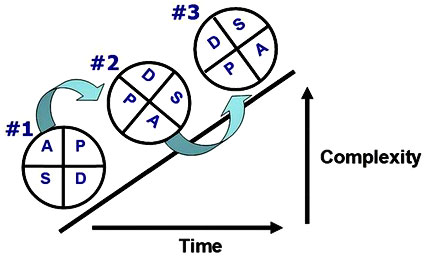Knowledge management in projects and organizations
Developed by Aitor Altuna
Knowledge management (KM) is the process of capturing, developing, sharing, and effectively using organizational knowledge. [1] The aim of this article is to identify within a project in an organization how knowledge is created, transferred and reused in a project management environment. Two main areas will be studied: intra-project and inter-project learning and organizational memory and knowledge sharing.
Intra-project learning consists of knowledge created and shared within a project, whereas inter-project learning is based in reusing existing knowledge from project to project. There are mainly two types of knowledge: explicit and tacit. Explicit knowledge is knowledge that is expressed tangibly and can potentially be stored in databases or documents. Tacit knowledge, instead, is stored in a person´s head and cannot be readily expressed in words. Managing both of them correctly within an organization is essential for effective knowledge management.[2]
Intra and inter-project learning is explained through the Plan-Do-Study-Act (PDSA) cycle. The PDSA cycle is based on the premise that for an organization to continually improve or learn they need to plan for it, implement the plan, analyse or study the results and act on the analysis. Intra-project learning is the process in which new knowledge is created when overcoming problems in projects. Intra-project learning can occur in different ways but should be documented in order to transfer it to other projects within the company. This concept is called knowledge reuse.[2]
Knowledge that is gained in different projects needs to be transferred to an organization's memory for reuse on other projects. This information transfer is essential for the organization's prosperity. Therefore, a knowledge management strategy should developed to determine how knowledge should be reported, stored, shared and used.[3]
Importance of knowledge management
Knowledge is a vital resource in project-based industries such as aerospace, construction, shipbuilding and software. Considering management of knowledge is a necessary prerequisite for project success in today’s dynamic and changing environment. [4]
Key business objectives for project management in companies are to: increase customer retention and acquisition, increase returns on projects, and minimize risks. Crucial factors in achieving these objectives are related to managing, applying and reusing knowledge gained throughout the project life cycle. If useful information is identified, assimilated and retained within the organization, it represents intellectual capital that can be reused on other projects, reducing the time staff spend recreating what has already been learned, and therefore improving project management in general. Such organizations must continually develop their core competencies or project management capabilities to successfully win and execute projects to meet client needs.[2]
Effective project management is a key enabler for business success. However, where corporate knowledge is ineffectively managed during the project lifecycle, valuable intellectual capital is lost or devalued, causing rework and lost opportunities. The management and transfer of knowledge can support an organization in improving organizational learning. From the project management point of view, this in turn should help deliver more projects on time and within budget, or alternatively deliver projects of a higher quality for an increased profit. This also leads to higher customer satisfaction and better reputation for the organization.[2]
To succeed competitively and to achieve their business strategies and goals, organizations such as project management organizations need an effective knowledge management strategy in order to maintain valuable intellectual capital and not causing rework to employees. Effective knowledge management and learning are also essential to ensure a qualified and polyvalent staff. It also affects to the personal satisfaction of employees, as they consider their work to be valuable and efficient. For technology-based organizations, continuous learning is a helpful strategy to remain innovative.[2]
Intra and inter project learning and knowledge creation
In a company, two projects will never be exactly the same. Possibilities to find similar projects are high, but each project is unique due to several factors such as project definition, tasks or members, among others. Therefore, projects are especially suitable for learning. [5]
PDSA cycle

The Plan-Do-Study-Act (PDSA) cycle is an iterative, four-stage problem-solving model used for improving a process or carrying out change. It is also known as the PDCA cycle (Plan-Do-Check-Act) or the Deming wheel. Applied to the field of knowledge management, it is used to characterize knowledge creation and learning in a project management environment, and is linked to the Project Management Institute´s Project Management Body of Knowledge (PMBOK). The PDSA model is valid to explain two possible situations in a project-based environment. On the one hand, it can explain the process within a project where an iterative process is used to find the best solution for a problem. This means that inside a project there are several PDSA cycles, and the design is improved and refined until the final solution is obtained. On the other hand, taking into account that a project is a single PDSA cycle, it explains how knowledge that is gained from one project can be saved and transferred to be reused in future projects.[2]
Cite error:
<ref> tags exist, but no <references/> tag was found